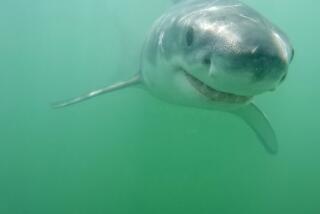Are squid vicious?
- Share via
LA PAZ, Mexico — I STAND on the deck of the boat with a tank of air on my back, a weight belt around my waist and images of space aliens swarming my mind.
Beneath me prowl thousands, perhaps millions of creatures that might as well be from another world -- voracious animals with probing arms and tentacles lined with hundreds of gripping suckers and clasping hooks, and with beaks designed to tear off fist-sized hunks of flesh.
Marine biologists have a lot to learn about the Dosidicus gigas, a.k.a. Humboldt squid, or jumbo squid. What they know is that these cephalopods can reach lengths of 7 feet and weigh as much as 100 pounds, that these torpedo-shaped mollusks thrive at great depths and use a form of jet propulsion to squirt themselves quickly through their hazy realm, and that they’re extremely strong and agile.
“Dosidicus is the Arnold [Schwarzenegger] of the squids, for sure,” says William F. Gilly, a professor of biology at Stanford University’s Hopkins Marine Station. “They are the most powerful squid and have quite the armament for dealing with big prey: thousands of rings and sucker cups. Yet to see them feeding on the little fish in the wild is really interesting. They reach out so delicately and grab them as though they’re eating snacks at a cocktail party.”
Long common off South America, they began establishing themselves in the Gulf of California -- better known as the Sea of Cortes -- in the 1970s. Now their growing numbers and intriguing behavior have scientists stumped. At the moment, I’m waiting for a deckhand to haul into view a squid he’s hooked with a hand line. With it will come others, he assures me, because these are cannibals, quick to sense trouble among their own.
“Some assurance,” I mutter. I try not to think about the stories I’ve heard, notably one in which this same species in this same general area turned an Arizona marine biologist’s dive into a scene from a bad horror movie.
*
New sea stars
Jacques Yves Cousteau once described the southern Sea of Cortes as the Galapagos of North America. For years, divers mingled wide-eyed beneath the enormous schools of hammerhead sharks that gathered over seamounts. Sport fishermen waged epic battles with marlin, tuna, swordfish and sailfish.
But over time, subsistence fishermen tossing spark plug-weighted hand lines from skiffs, leathery gringos living out Hemingway fantasies, and, most significantly, commercial boats setting monofilament nets and lines with baited hooks, depleted the number of fish.
Now, only old-timers can remember when an angler could look out over the water and see tuna leaping for miles and crowds of marlin and sailfish sunning on the surface.
Sharks, in particular, have suffered. Carlos Villavicencio, a professor of marine biology at the University of Baja California Sur in La Paz, says that his interviews with fishermen suggest that the number of sharks caught has dropped by about 40% since 1990.
Mexico has, over the years, more forcefully regulated fishing and now has a 50-mile exclusion zone to keep large-scale commercial fishing well offshore. But it continues to allow the limited use of drift gill nets and long-lines inside the zone, and inside the gulf as part of an experiment to gather data before publishing a new shark norma, or regulation.
Meanwhile, over the last three decades, the fast-growing, short-lived Humboldt squid, has been making long seasonal visits in numbers that seem to be growing. And in recent years, particularly in the Santa Rosalia and Guaymas areas north of La Paz, they’ve taken up year-round residence, feeding largely on lanternfish, small, deep-sea creatures that rise to shallower depths at night -- which is when squid feed.
Is the Sea of Cortes squid invasion a sign that one of the richest marine areas of the world is ailing? Commercial fishing frequently cuts the overall age of species in an ecosystem, says Gary Thomas, a professor of fisheries ecology at the Rosensteil School of Marine and Atmospheric Sciences.
So it makes sense, he says, to assume that in the gulf, heavy fishing of once-stable populations of long-living finned fish would lead to “rapidly changing, highly fluctuating stocks of short-lived species, such as squids.”
That, he adds, probably explains why some of the world’s most overfished coastal waters -- such as those off Japan -- are dominated by squid.
Some scientists suggest a link between the squid surge and the decline of large predators -- and they note other possible ripples across the ecosystem. What will the effect be on the lanternfish population, for example? And is there a connection to the appearance of more toothed whales in the gulf?
“As squid are lacking predators in large numbers, they are growing very large, which is attractive to sperm whales,” says Juan Pablo Gallo Reynoso, a marine mammal researcher based in Guaymas.
Predictably, perhaps, the squid influx has spurred other migrations to the southern gulf. Scientists are swarming in seeking clues to the bio-mysteries; documentary crews have come to gather footage of an animal they think may hold the same sort of charismatic power as sharks to glue eyes to a screen.
And at least one La Paz outfitter, Baja Quest, is exploring the possibility that there’s profit to be made shepherding people to these waters to dive with squid.
*
Mugged by mollusks
The trip aboard Baja Quest’s 48-foot Garota begins with an afternoon warm-up dive at a small reef outside La Paz Bay near Espiritu Santos Island. The air is warm and the water clear and beautiful, with wonderful avenues that meander between walls of coral and rock. Beyond the reef, slender garden eels protrude from holes in the sand, wavering in the current like serpents in a trance. Bigeye jacks are so numerous that they cast a giant shadow over the divers. A barracuda looms menacingly in the distance.
By nightfall Garota has traveled to the island’s northeast shore. Soon the deckhand dangles a string of lights over the port rail, and squid begin to dart in and out of the darkness. I forgo this first attempt to swim with them -- remembering that squid feed by night. But Jim Knowlton, a cameraman and film editor with Jean-Michel Cousteau’s Ocean Futures Society, jumps right in. Diving to about 30 feet, he disappears, but his flashing camera marks his progress.
One of the first attempts to film the behavior of Dosidicus gigas was in 1990 north of La Paz off little San Diego Island. One night, three cameramen and Arizona marine biologist Alex Kerstitch illuminated a patch of dark sea and splashed in.
Squid, which travel headfirst with their tentacles tightly clasped and point-shaped around their beaks, are careful around things larger then they are -- until they sense opportunity. Soon, the mollusks were shooting about like rubber missiles. Some changed colors from a translucent white to blood-red, several times per second -- as if they had swallowed strobes (some biologists believe this to be an elaborate means of communication).
At one point, as Kerstitch was underwater, a passenger stood on the deck fighting a 12-foot thresher shark with rod and reel. At about 30 feet, Kerstitch caught a glimpse of the shark -- and of a large squid flinging itself at the struggling predator.
The squid quickly dashed away but not before removing “an orange-sized chunk of flesh from the side of the shark’s head with its powerful beak,” Kerstitch told me not long after the encounter. Other squid then turned on the diver. One latched onto his fin and pulled him down. Curious, Kerstitch let it pull, which may have provided this sense of opportunity.
Kerstitch kicked and the first squid let go. But another attached itself just above his shoulders. “It was like somebody was throwing a cactus on my neck,” he recalled.
He struck the animal with his dive light and it let go, taking a gold chain he had been wearing. Another squid then wrapped its arms and tentacles around his face and chest. He buried his fingers into the body of the squid and began to pull. It slid to his waist and let go, taking his decompression meter.
Kerstitch escaped and flopped back onto the boat, glad to be alive but burning with nasty lesions. “These could eat one of us in a New York second, if that’s what they wanted,” says Roger Hanlon, senior scientist at Marine Biological Laboratory in Woods Hole, Mass. “Two gnashes of that beak and your wrist could be gone.”
Hanlon questions whether it’s prudent to let the public swim freely with squid. The animals are too unpredictable, he says. Others, including Stanford’s Gilly, say there’s no real danger if the divers are experienced and don’t get reckless.
*
A tentacle’s touch
Back on the Garota, Knowlton sloshes aboard saying he felt safe amid the squid -- that he has never felt threatened by an animal that seemed as curious of him as he was of it.
“I tried to single out one at a time,” he says. “And as I would look at it, and swim toward it, it would come toward me.” One squid, he says, gingerly reached out with its longest tentacles trying to touch his strobe.
That’s an image I can’t shake as the Garota continues south to a remote area near the fishing village of La Ventana, just beyond Cerralvo Island.
Millions of stars twinkle overhead. In the distance, lightning flashes. Dawn reveals a desert landscape practically untouched by civilization.
The people here live as generations have before them: by fishing aboard skiffs with hand lines.
Some also carry sportfishing clients from the United States, who are shuttled overland via van, and on this warm morning, they’re all fishing side by side a mile or so offshore, going deep after the same species, Dosidicus gigas, which they’re hauling in one after another over the rails of their skiffs.
I watch the haul with interest as I adjust my regulator and mask. Finding myself in a now-or-never state of mind, I’ve asked to jump overboard first this morning. The dive master and her husband reluctantly give their OK, but only after I promise to wait for them at 30 feet. I fall away from the boat and point my head down.
Ten feet becomes 20, which becomes 30 ... 40 ... 50....
Not realizing the depths to which I have traveled, I stop at 60 feet and look up, trying to find my dive companions. My gaze shifts down again. I’m surrounded by another type of companion. Hovering around the deckhand’s catch are nearly a dozen squid, all about 4 feet long and fanned at various angles like alien vessels hovering in outer space.
In a blink, several launch themselves my way, one after another, tentacles extended as if to embrace me -- or ...
I raise my arms and brace for assault. It doesn’t come. Instead, I find myself confronting the large, black eyes of the leader. As if intrigued by the even larger green eyes staring back through my mask, its gaze is so piercing the squid seems to be reading my mind.
I sweep my right arm frantically upward, as if warding off a left hook. The leader sweeps off with the others following at what seems like light speed.
I turn to face a second assault, but the creatures have vanished. Just then, the divers materialize with raised arms and upturned palms, as if to say, “Anything?”
I can only gesture. It doesn’t matter, they tell me later. My eyes said it all.






